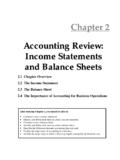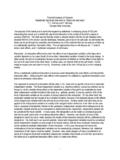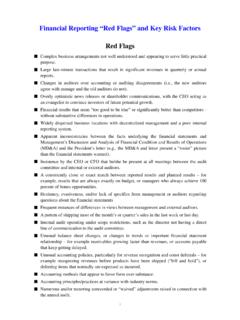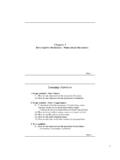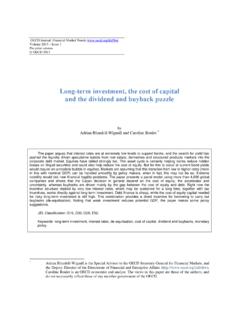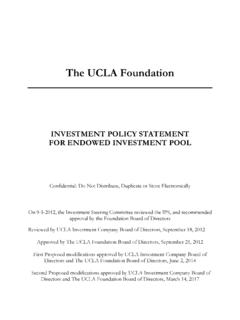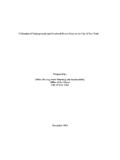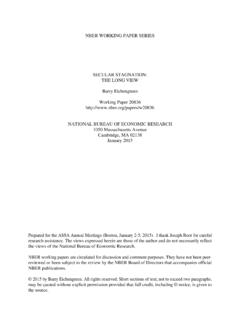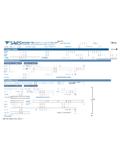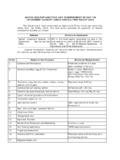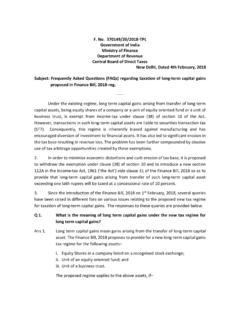Transcription of Chapter 11 The Cost of Capital - Georgia State University
1 Harcourt, Inc. items and derived items copyright 2002 by Harcourt, Inc. Answers and Solutions: 11- 1 Chapter 11 The cost of Capital ANSWERS TO SELECTED END-OF- Chapter QUESTIONS 11-1 a. The weighted average cost of Capital , WACC, is the weighted average of the after-tax component costs of Capital -debt, preferred stock, and common equity. Each weighting factor is the proportion of that type of Capital in the optimal, or target, Capital structure. b. The after-tax cost of debt, kd(1 - T), is the relevant cost to the firm of new debt financing. Since interest is deductible from taxable income, the after-tax cost of debt to the firm is less than the before-tax cost . Thus, kd(1 - T) is the appropriate component cost of debt (in the weighted average cost of Capital ). c. The cost of preferred stock, kps, is the cost to the firm of issuing new preferred stock. For perpetual preferred, it is the preferred dividend, Dps, divided by the net issuing price, Pn.
2 Note that no tax adjustments are made when calculating the component cost of preferred stock because, unlike interest payments on debt, dividend payments on preferred stock are not tax deductible. d. The cost of new common equity, ke, is the cost to the firm of equity obtained by selling new common stock. It is, essentially, the cost of retained earnings adjusted for flotation costs. Flotation costs are the costs that the firm incurs when it issues new securities. The funds actually available to the firm for Capital investment from the sale of new securities is the sales price of the securities less flotation costs. Note that flotation costs consist of (1) direct expenses such as printing costs and brokerage commissions, (2) any price reduction due to increasing the supply of stock, and (3) any drop in price due to informational asymmetries. e. The target Capital structure is the relative amount of debt, preferred stock, and common equity that the firm desires.
3 The WACC should be based on these target weights. f. There are considerable costs when a company issues a new security, including fees to an investment banker and legal fees. These costs are called flotation costs. g. The cost of new common equity is higher than that of common equity raised internally by reinvesting earnings. Project s financed with external equity must earn a higher rate of return, since they project must cover the flotation costs. 11-2 The WACC is an average cost because it is a weighted average of the firm's component costs of Capital . However, each component cost is a Answers and Solutions: 11 - 2 Harcourt, Inc. items and derived items copyright 2002 by Harcourt, Inc. marginal cost ; that is, the cost of new Capital . Thus, the WACC is the weighted average marginal cost of Capital . 11-3 Probable Effect on kd(1 - T) ks WACC a.
4 The corporate tax rate is lowered. + 0 + b. The Federal Reserve tightens credit. + + + c. The firm uses more debt; that is, it increases its debt/assets ratio. + + 0 d. The dividend payout ratio is increased. 0 0 0 e. The firm doubles the amount of Capital it raises during the year. 0 or + 0 or + 0 or + f. The firm expands into a risky new area. + + + g. The firm merges with another firm whose earnings are countercyclical both to those of the first firm and to the stock market. - - - h. The stock market falls drastically, and the firm's stock falls along with the rest. 0 + + i. Investors become more risk averse. + + + j.
5 The firm is an electric utility with a large investment in nuclear plants. Several states propose a ban on nuclear power generation. + + + 11-4 Stand-alone risk views a project s risk in isolation, hence without regard to portfolio effects; within-firm risk, also called corporate risk, views project risk within the context of the firm s portfolio of assets; and market risk (beta) recognizes that the firm s stockholders hold diversified portfolios of stocks. In theory, market risk should be most relevant because of its direct effect on stock prices. 11-5 If a company s composite WACC estimate were 10 percent, its managers might use 10 percent to evaluate average-risk projects, 12 percent for those with high-risk, and 8 percent for low-risk projects. Unfortunately, given the data, there is no completely satisfactory way to specify exactly how much higher or lower we should go in setting risk-adjusted costs of Capital .
6 Harcourt, Inc. items and derived items copyright 2002 by Harcourt, Inc. Answers and Solutions: 11- 3 SOLUTIONS TO SELECTED END-OF- Chapter PROBLEMS 11-1 40% Debt; 60% Equity; kd = 9%; T = 40%; WACC = ; ks = ? WACC = (wd)(kd)(1 - T) + (wce)(ks) = ( )(9%)(1 - ) + ( )ks = + = ks = 13%. 11-2 Vps = $50; Dps = $ ; F = 5%; kps = ? kps = )F1(VDpsps = ) (50$ $ = $ $ = 8%. 11-3 P0 = $30; D1 = $ ; g = 5%; ks = ? ks = 01PD + g = + = 15%. 11-4 a. kd(1 - T) = 13%(1 - 0) = b. kd(1 - T) = 13%( ) = c. kd(1 - T) = 13%( ) = 11-5 kd(1 - T) = ( ) = 11-6 kps = ) ( $) (100$ = ) ( $11$ = $11$ = 11-7 Enter these values: N = 60, PV = , PMT = 30, and FV = 1000, to get I = 6% = periodic rate. The nominal rate is 6%(2) = 12%, and the after-tax component cost of debt is 12%( ) = Answers and Solutions: 11 - 4 Harcourt, Inc. items and derived items copyright 2002 by Harcourt, Inc.
7 11-8 a. ks = 01PD + g = 23$ $ + 7% = + 7% = b. ks = kRF + (kM - kRF)b = 9% + (13% - 9%) = 9% + (4%) = 9% + = c. ks = Bond rate + Risk premium = 12% + 4% = 16%. d. The bond-yield-plus-risk-premium approach and the CAPM method both resulted in lower cost of equity values than the DCF method. The firm's cost of equity should be estimated to be about percent, which is the average of the three methods. 11-9 a. $ = $ (1+g)5 (1+g)5 = = (1+g) = (1/5) = g = 8%. Alternatively, with a financial calculator, input N = 5, PV = , PMT = 0, FV = , and then solve for I = 8%. b. D1 = D0(1 + g) = $ ( ) = $ c. ks = D1/P0 + g = $ $ + 8% = 11-11 a. Common equity needed: ($30,000,000) = $15,000,000. b. cost using ks: After-Tax Percent cost = Product Debt * Common equity WACC = *8%(1 - T) = 8%( ) = c.
8 Ks and the WACC will increase due to the flotation costs of new equity. 11-12 a. After-tax cost of new debt = kd(1 - T): kd(1 - T) = (1 - ) = = cost of common equity = ks: ks = D1/P0 + g. Harcourt, Inc. items and derived items copyright 2002 by Harcourt, Inc. Answers and Solutions: 11- 5 Using the point-to-point technique, g = Thus, ks = $ ( )/$ + 8% = + 8% = b. WACC calculation: % Capital After-Tax Component Component Structure cost cost Debt Common equity WACC = 11-13 The book and market value of the current liabilities are both $10,000,000. The bonds have a value of V = $60(PVIFA10%,20) + $1,000(PVIF10%,20) = $60([1 ]-[1/( *(1+ )20)]) + $1,000((1+ )-20) = $60( ) + $1,000( ) = $ + $ = $ Alternatively, using a financial calculator, input N = 20, I = 10, PMT = 60, and FV = 1000 to arrive at a PV = $ The total market value of the long-term debt is 30,000($ ) = $19,783,800.
9 There are 1 million shares of stock outstanding, and the stock sells for $60 per share. Therefore, the market value of the equity is $60,000,000. = Answers and Solutions: 11 - 6 Harcourt, Inc. items and derived items copyright 2002 by Harcourt, Inc. The market value Capital structure is thus: Short-term debt $10,000,000 Long-term debt 19,783,800 Common equity 60,000,000 $89,783,800 11-14 This is not an easy question. Basically, we must fall back on our confidence in the parameter estimates that go into each model. The CAPM requires estimates of beta, kM, and kRF. If the Capital markets have been unusually volatile recently, the estimates for kRF and kM may be suspect. Further, if the riskiness of the firm is changing, it is unlikely that a beta estimate based on historical data would reflect the expected future market risk of the firm.
10 Thus, highly volatile Capital markets and changing risk would lower our confidence in the CAPM estimate. The key variable in the DCF model is the dividend growth rate. If the stock has experienced relatively constant historical dividend growth and if this trend is expected to continue, then (1) the constant growth model can be used, and (2) we can have some confidence in our estimate of g. If dividend growth has been erratic, the constant growth model is unsuitable and we have considerably less confidence in our g estimates. Institutional Brokers Estimate System (IBES) compiles the 5-year dividend growth estimates of numerous analysts and publishes the median and standard deviation of g estimates. A large standard deviation would indicate a lack of consensus among analysts, and would lessen our confidence in the DCF model. Thus, the DCF model would be most useful when there is consensus of forecasts and constant growth.


